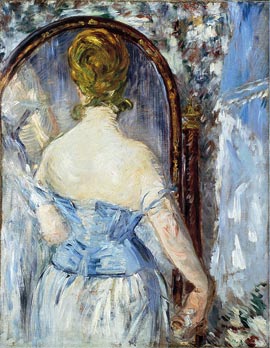 |
 |
 |
 |
 |
|
| Edouard Manet Before the Mirror, 1876 Oil on canvas, 92.1 x 71.4 cm Solomon R. Guggenheim Museum, New York, Thannhauser Collection, Gift, Justin K. Thannhauser 78.2514.27 |
||
In 1865 Edouard Manet shocked Parisian audiences at the Salon with his painting Olympia (1863), an unabashed depiction of a prostitute lounging in bed, naked save for a pair of slippers and a necklace. While not an unpopular subject in nineteenth-century French painting, the courtesan had rarely been portrayed with such honesty. The artist provoked a similar scandal when his painting Nana (1877)—depicting a coquettish young woman in a state of partial undress powdering her nose in front of an impatient client—was exhibited in a shop window on the boulevard des Capucines. Manet's attention to a motif conventionally associated with pornography reflected his desire to render on canvas the truths of modern life. It was a theme that symbolized modernity for many late-nineteenth-century artists and writers, including Edgar Degas and Emile Zola, who devoted their work to realistic portrayals of the shifting class structures and mores of French culture. Manet's endeavor to capture the flavor of contemporary society extended to portraits of barmaids, street musicians, ragpickers, and other standard Parisian "types" that were favorite subjects of popular illustrated literature. Images of courtesans may be found throughout Manet's oeuvre; Before the Mirror is thought to be one such painting, related iconographically to Nana, but more spontaneous in execution. The artist's vigorous brushstrokes lend an air of immediacy to the picture. As in Nana, the corseted woman represented here admires her reflection in a mirror; but this particular scene is extremely private—the woman, in quiet contemplation of her own image, is turned with her back to the viewer. Before the Mirror exemplifies Manet's use of seemingly improvised, facile brushstrokes that emphasize the two-dimensionality of the canvas while simultaneously defining form and space. From our vantage point, it is less Manet's choice of subject matter than the tension between surface and subject, in which the paint itself threatens to dissolve into decorative patterns, that defines his work as quintessentially Modern. —Nancy Spector |